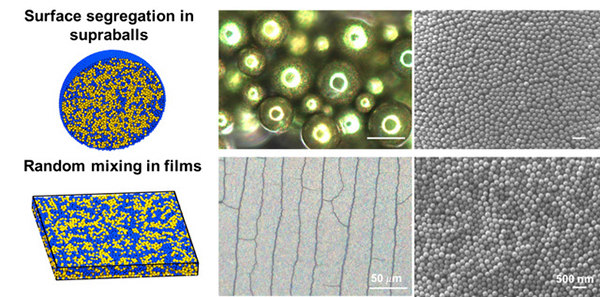Peacock feathers are alluring, bright and colorful. They are also favorable subjects for the basis of scientific investigation and just might change the way consumers experience color in the future.
Research inspired by such bird feathers could lead to the production of more vivid colors in such things as cosmetics and wide-angle displays on tablets and televisions. Take, for example, the research recently completed by Dr. Ali Dhinojwala, interim dean of the College of Polymer Science and Polymer Engineering at The University of Akron; current Ph.D. student Weiyao Li, and former students Ming Xiao, Ph.D. and Xiaozhou Yang, M.S.; along with others at Northwestern University, University of Delaware and Ghent University in Belgium. Their research article, “Experimental and theoretical evidence for molecular forces driving surface segregation in photonic colloidal assemblies,” was recently published in the journal Science Advances.

This image shows that when mixing the same volume fraction of 220 nanometers of melanin and 220 nanometers of silica particles, segregation occurs in superballs, but not in films. This leads to the color differences.
“Inspired by bird feathers, we want to control the surface packing of melanin particles to create (more vivid) structural colors,” said Xiao, lead author of the article. “Bird feathers are unique in producing structure colors by using organizing melanin particles in ordered patterns, like hexagonal or square.”

Dr. Ming-Xiao
Structural colors are colors that are reflected when microscopic surfaces interfere with visible light. On the peacock, for example, tail feathers have brown pigment, or melanin, but their microscopic structure makes them reflect the dazzling colors we typically see in peacocks — blue, green and turquoise. If the team can control the way the particles come together on a surface, they can influence the vividness of the colors that are reflected.
In their research, the group members studied the effects of particle chemistry and size on groupings within crystals that are made of mixtures of melanin and silica. Using experiments and simulations, they found that melanin can strongly segregate at micro-size supraball surfaces but not on flat films. This work demonstrates that the control of particle packing using different particle sizes, chemistries, or assembly methods offers new opportunities to produce desired colors or gradient surface properties for coatings.
“This work enhances our understanding of the assembly and surface segregation of polymeric colloids at the interfaces,” said Xiao. “This understanding will guide us to construct more polymers with finer tuned surface structures that lead to desired properties, like structure colors” — which, he added, have the potential to be used in applications ranging from cosmetics, paints and textiles to wide-angle displays.
Professors from other universities who contributed to this paper were Dr. Matthew D. Shawkey, Ghent University; Dr. Nathan C. Gianneschi, Northwestern University; and Dr. Arthi Jayaraman, University of Delaware. Contributing students were Ziying Hu, Northwestern University; and Thomas E. Gartner III, University of Delaware.
Media contact: Alex Knisely, 330-972-6477 or aknisely@uakron.edu.
